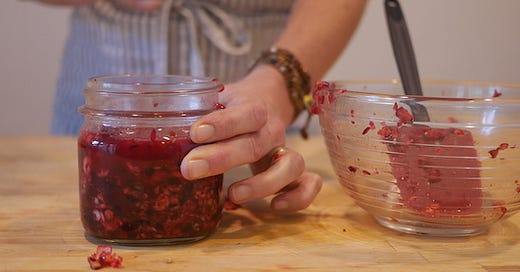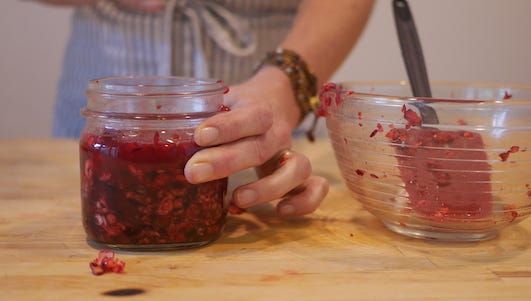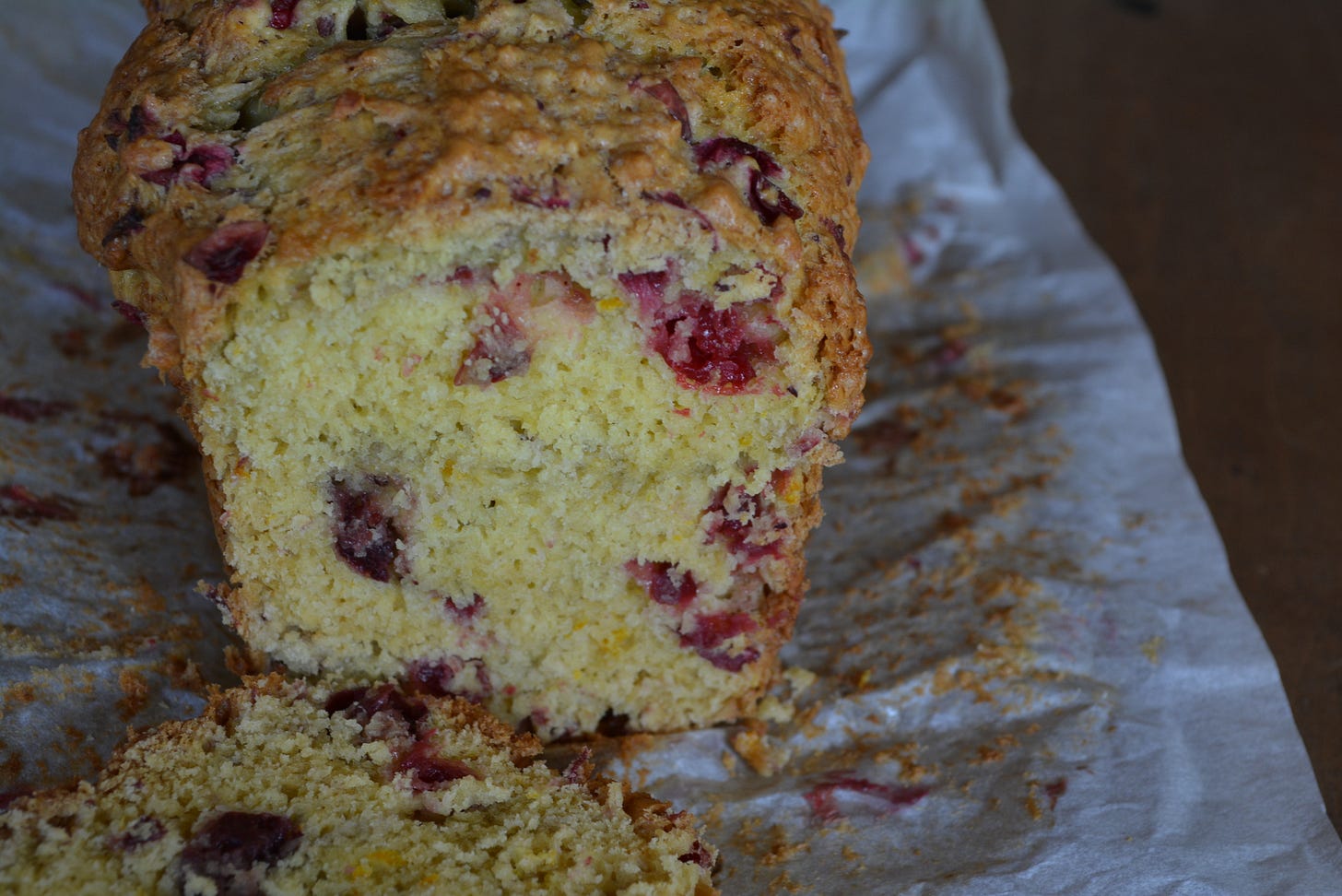Turning in
This past weekend, on Saturday, for the first time in five years, all four of our children were home at the same time. We spent time soaking up the last of autumn and eating meals with gratitude that we had this day together. I made it through the day without tearing up, too much…
I made cranberries because in Oregon the locally grown ones are now available and I know my kids love them. I didn’t have time to ferment them into our favorite relish and I didn’t have as many as I knew our group of thirteen would eat. I wanted to stretch and on a whim decided to add a pint of apple butter. I simmered the couple cups of cranberries with the apple butter for around 45 minutes. It was a hit. This was a happy experiment that will be repeated often.
The next day I walked, with my heart full and also a little sad. Behind our home, there is place I go to breathe and allow the forest to bring me back. This spot is a dry basin tucked along the side of an unnamed ridge in the tangle of the Siskiyou mountains. It is a bowl, a rounded depression formed by seasonal run-off that has remained an, increasingly rare, archetypal slice of a healthy Pacific Northwest conifer forest. Which is another way of saying that it has been approached, logged, or mined over the last 150 years with a much lighter touch than most of the surrounding stands—both proximate and distant.
We walk here often. This time of year it is both grounded and ethereal. Resilient, thick dark vertical fire-scarred trunks of old-growth firs reach from the deep brown duff of the forest floor. These grand dames are spaced far apart with massive branches bedecked with delicate needles that high above and beyond the line of sight reach and drape to create the canopy.
The slope cradling this mixed evergreen wood is north-facing and in November it is turning inward. Outward growth retreats while microbial growth wakes wetted again by fall rain, the fragrance of honey and mushrooms—sweet-scented decay—replaces the smell of summer heat on pine oil. Mosses and lichens rehydrate—restored and lush momentarily extinguishing the strain of the parched drought-stricken landscape conveying instead soft, quiet serenity.
In a bit of visual trickery, the light comes from below. The understory radiates as otherworldly light hovers in the in between.
Only half of the pale-yellow leaves of the western beaked hazel (Corylus cornuta var. californica) are still holding on. Therefore, the leaves appear to float above the ground, untethered, like fairy lanterns, emitting soft dappled light where the sun doesn’t shine. A bit higher in the mid-layer the last of the light-salmon-colored leaves of the Pacific dogwoods punctuate the view. The huge golden leaves of aptly named Big Leaf maples look like whimsical flames of paper bonfires in the distance.
Cranberries
This week I will ferment cranberries for holiday meals and beyond. I love taking advantage of this season of red ripe abundance and stretching it through the winter. In this week’s paid subscriber post we will dive into cranberries and their role in gut health.
I hope you make one or more of the recipes below. Let us know in comments. The relish we eat as is but the pickled cranberries I use in recipes, such as the cranberry bread recipe that follows the two fermentation recipes.
Cranberry Ginger Relish
Makes about a quart
This relish has a warm ginger flavor. If you want a strong spicy gingery-heat use the full amount of the fresh and the optional candied ginger after fermentation. The juice-sweetened dried cranberries balance the tartness of fresh ones. If the finished relish is not sweet enough for your taste simply splash in a bit of maple syrup or honey before serving. Note: Though it’s always better to use fresh ingredients, you can make this relish with frozen cranberries. It’ll have a softer consistency, but is otherwise just as delightful.
2 (8-ounce) packages fresh cranberries
1 cup fruit juice–sweetened dried cranberries
½ teaspoon unrefined sea salt
1–1 ½ tablespoons ginger, finely grated
Optional: add 1 more tablespoon chopped candied ginger after the fermentation
Wash the fresh cranberries and put them in a food processor; pulse until lightly chopped. Transfer to a bowl and massage in the salt for a minute to develop the brine. Then mix in dried cranberries and fresh grated ginger. Press the mixture into a quart jar or small crock, making sure there are no air pockets.
Top the ferment with a quart-sized ziplock bag. Press the plastic down onto the top of the ferment, then fill it with water and seal; this will act as both follower and weight. Set aside to ferment, somewhere nearby and out of direct sunlight, in a cool spot for 5 to 7 days. Check daily to make sure the fruit stays submerged.
As the ferment develops it will become the same deep crimson color of cooked relish. Around 5 days you can check it. When it is ready the flavors will have mingled into a spicy sweet tart flavor. It will have two sour notes: one from the cranberries one from fermentation. This is where you will add the optional candied ginger.
To store ladle the finished ferment into smaller jars, leaving as little headroom as possible, and tamp down under the brine. Pour in any remaining brine to cover. Tighten the lids, then store in the fridge. This ferment will keep, refrigerated for 6 months
Pickled Cranberries
Makes about a quart
These pickles are beautiful, fun, delicious, pack a pucker, and are good for conversation at the table. Add these pickled cranberries, whole or lightly chopped, to anything that you want to add color and zing to—salad, coleslaw, yep even sauerkraut. Really. Or, follow the recipe below for Cranberry Orange Bread.
When you add the brine these petite red pickles will bob to the top of the liquid. It is important to make sure that you follow and weight this ferment down as the trickiest part about pickling cranberries is that they float, which can make it a challenge to keep everything under the brine.
2 (8-ounce) packages fresh cranberries
5 slices fresh or candied ginger
2 cinnamon sticks
1 tablespoon whole cloves
1 quart Basic Brine (1/8 cup unrefined sea salt to 1 quart unchlorinated water)
Rinse the cranberries in cold water and combine with the ginger, cinnamon, and cloves in a large bowl; mix thoroughly. Pack the mixture into a small crock or 2-quart jar. Pour in the brine to cover the cranberries completely. Reserve any leftover brine in the fridge. (It will keep for 1 week; discard thereafter and make a new batch, if needed.)
Place a grape leaf, a bit plastic wrap or a round of food safe screening over these buoyant berries that want to float out of the brine. For a crock, top with a plate that will rest atop the berries, and a weight such as a sealed water-filled jar to keep things in place, loosely cover the vessel with a clean kitchen towel. If using a jar, top with a smaller sealed water-filled jar or a water-filled ziplock bag. Loosely cover the jar with a clean kitchen towel. Set aside on a baking sheet to ferment, somewhere nearby and out of direct sunlight, in a cool spot for 7 to 21 days. During the fermentation period, monitor brine level and top off with the reserved brine solution, if needed, to cover. You may see foam on top; it is harmless, but if you see mold, scoop it out.
As the mixture ferments, the berries begin to lose their vibrant color. The brine will become slightly cloudy and be the color of a rich rosé wine. They may be ready in as soon as 7 days. They’re ready when this brine tastes acidic, like spiced vinegar. The berries will taste pickled. If they’re not sour enough, rinse the followers, put everything back in place, and continue monitoring brine level.
When it is ready transfer the cranberries into small clean jars, then pour in the brine, adding fresh brine to cover. Top with clean grape leaves, if you have some, then screw on the lids and store in the fridge. These pickles will keep, refrigerated, for 12 months.
Cranberry Orange Bread
Makes 2 mini loaves
This bread has a rich citrus flavor punctuated by the tart spiced fermented berries. In this recipe the fermented cranberries are coarsely chopped to distribute them through the bread. However, if you love the surprise of a strong whole berry when it bursts in your mouth just mix in the pickled cranberries whole.
2 ½ cups unbleached white flour, or your favorite GF mix
¾ cup unrefined sugar
2 teaspoons baking powder
½ teaspoon baking soda
¼ teaspoon salt
1 large orange, zest and juice about ½ cup
2 large eggs
4 tablespoons butter, melted
2 cups fermented cranberry pickles, drained and coarsely chopped
Optional: ½ cup walnuts, chopped
Preheat oven to 350° F.
Line two 5 ¾“ by 3 ¼“ mini loaf pans with parchment paper and set aside.
In a large bowl, sift or stir together flour, sugar, baking powder, baking soda, and salt.
Zest and juice the orange. Put 1 teaspoon of zest and ½ cup of the juice in a small bowl. Add to this eggs and butter and whisk or fork beat until well mixed.
Add the egg mixture to the flour mixture; with a wooden spoon, stir until batter is just mixed. It will be a stiff batter. Fold in the coarsely chopped cranberries and optional nuts.
Spoon equal amounts of batter into each of the prepared loaf pans. Bake 40 to 50 minutes or until toothpick inserted in the center of the loaf comes out clean. Cool in pan on a wire rack for 15 minutes then remove from pan and continue to cool on the wire rack.








Thank you, looks great! I’ll definitely try this recipe!
These all look delicious. Happy Thanksgiving!